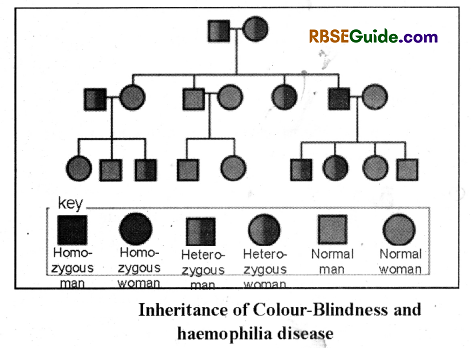Rajasthan Board RBSE Class 12 Biology Notes Chapter 36 Man-Chromosomal Aberrations
Chromosome
In previous chapter we have studied Mendel’s laws of Inheritance. This chapter deals with the chromosomes, and chromosomal aberrations. The Chromosomes are thread like structures and are capable of self duplication. The Chromosomes are found in the nucleus and can easily be studied by providing specific dyes. They are hereditary vehicles carrying the genetic informations from one generation to the other. The Chromosomes are also called as “Physical Basis of Heredity”.
![]()
History
- Chromosomes were seen first time by a German scientist Hofmeister (1848) in pollen mother cell of plant Tradescantia. Wilhelm von Waldeyer (1888) gave the name chromosome to these structures.
- Strasburger (1902) described chromosomes for the first time.
- Sulton and Boveri (1903) stated that “hereditary particles are present on chromosomes”. Later it is known as Suttan-Boveri hypothesis.
- The term, factor was replaced by Johannsen. in (1909) with the term Gene.
Types of Chromosomes
Various kinds of organisms are found in the living kingdom, which contain different types of chromosomes in them, such as :
- Viral chromosome
- Prokaryotic Chromosome
- Eukaryotic Chromosome
Viral Chromosomes
- Akaryotes such as viruses do not have definite chromosomes.
- They have one or two strands of DNA or RNA.
- DNA/RNAmay be circular / Linear.
- DNA found in bactereophage is Liner/Circular.
- TMV (Tobaco Mosaic Virus) has one strand of RNA. It is bounded in capsid made up of protein.
![]()
Prokaryotic Chromosome
In prokary otes such as bacteria the chromosomes called nucleoids are found.
The shape is circular and size varies from 25 to 100 JJ.
Eukaryotic Chromosomes
Eukaryotic cells for example animals, plants and fungi cells, the chromosomes are confined in the nucleus. Hereditary’ material present in chromosomes is DNA and it is linked with histone and non-histone protiens. Number of DNA molecules (chromosomes) is fixed in a species and it ranges from 2 (in nematode animal) to 1600 (in some species of protozoans). Chromosome number is always constant for a particular species.
Example
(i) Ascaris megalocephctlci 2 diploid
(ii) Drosophila 8 diploid
(iii) Man 46 diploid
(iv) Antacantha (Protozoan) 1600 diploid
![]()
Human Chromosomes
Number of chromosomes found in human are 23 pairs means 46 chromosomes. Out of the 46 chromosomes, the 44 chromosomes are identical in man and woman, which are called somatic chromosomes or autosomes. One pair of chromosome differs in both sexes which is referred as Sex chromosome pair.
Sex chromoxome in human female has genotype XX and male has genotype XY. In males, out of XY chromosomes, one is large X chromosome while second Y chromosome is small. The women has identical sex chromosomes XX. The number of chromosomes represented in male is 44 + XY and in female is 44 + XX.
Sometimes changes in number of chromosomes may occur and number increased from total 46 chromosomes are termed as Supernumery or trisomy, Aneuploidy may be a case of loss of one.or both the homologous chromosome (2n – 1 or 2n – 2).
Human chromosomes are arranged in pairs on the basis of their sizes and each pair is known by a number. This arrangement is known as Karyotype. Diagramatic representation of this karyotype is called Idiogram.
Human Chromosomal Disorders (Abnormalities)
Chromosomal disorders occur due to change in number of chromosomes or change in their structure. These abnormalities are of two types :
- Autosomal Abnormalities
- Mongolism or Down’s Syndrome
- This abnormality was first described by Langdon Down in 1866.
- The person suffering from. Down syndrome has 47 chromosomes
- This is due to one extra 21st chromosome. Hence, it is also called 21st Trisomy.
- Down svndrome is found in one out of 600 children. Such defect is generally occurs in a child which is bom by
- the wroman of more than 40 years age. It is due to one extra 21st more chromosome the ovum at the time of meiotic division (expulsion of polar body), so instead of 23 chromosomes, there are 24 chromosomes in the ovum. A child develope from such ovum contains 47 chromosomes and abnormality develops is Down syndrome.
![]()
Salient Features
- They have protruding round heads, webbed neck.
- Furrowed tongue that cause the mouth to remain partially open and short.
- Broad hands with blunt fingers and characteristic
- Physical, psvchomotor and mental development is retarded. Life expectancy is shortened.
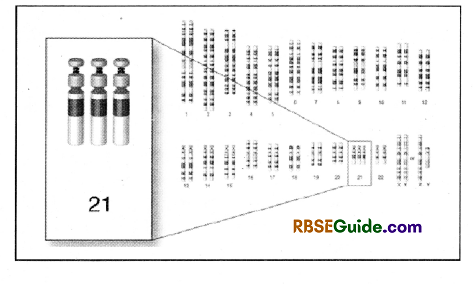
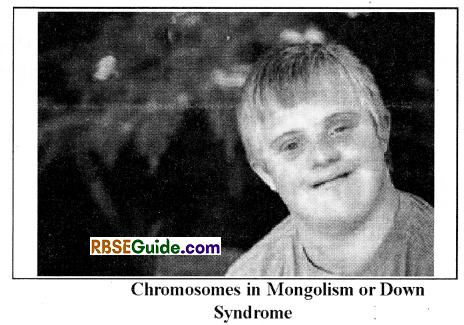
Edward’s Syndrome
It is caused due to one extra 18th chromosome (45 + 2 = 47). Hence, it is also called as 18th Trisomy.
It occurs in one out of 6000 persons.
Symptoms : Mentally retarded, congenital heart disease, Polydactylous, Maximum life of 6 month.
Cry du Chat Syndrome
- It is caused due to loos of small arm (p-arm) of 5th chromosome.
- It is also called as cat’s cry syndrome
- Symptoms : Microcephaly, Infant voice resembles cat’s cry.
Allosomal Abnormalities.
Following are main allosomal abnormaliteis.
- Turner’s Syndrome
- A person suffering from this disease is always a woman. Such woman has only one X chromosome instead of two and hence total number of chromosomes found are only 45 (44 + X 0). It is called Turner’s Syndrome.
- One girl bom per 3000 as turner syndrome.
- Symptoms:
- Such w omen are of short stature.
- Broad chest and lack of secondary sexual characteristics and sterile.
- Short neck, underdeveloped mammary glands
- Mental – retardness
![]()
Klein felter’s Syndrome
A person suffering from this disease is man. Such man has 47 or 48 or 49 total chromosomes instead of 46 in their cells. This additional number is either of X or Y chromosome. Klinefelter’s syndrome in man may have chromosomes as :
(i) 44 + XXY (One additional X chromosome) = 47
(ii) 44 + XXXY (two additional X chromosome) = 48
(iii) 44 + XXXXY (three additional X chromosome) = 49
(iv) 44 + XXYY (addition one X and one Y chromosome) = 48
(v) 44 + XXXYY (Additional two X and one Y chromosome) = 49
Such males with abnormal number of chromosomes has feminine characters. Specific features of a Klinefelter’s syndrome are :
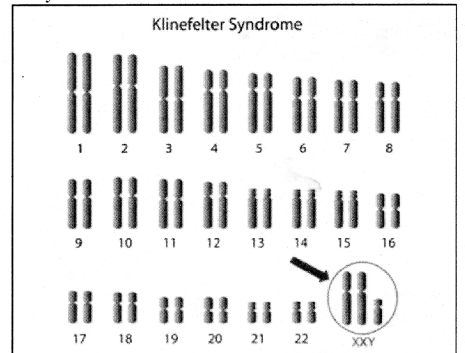
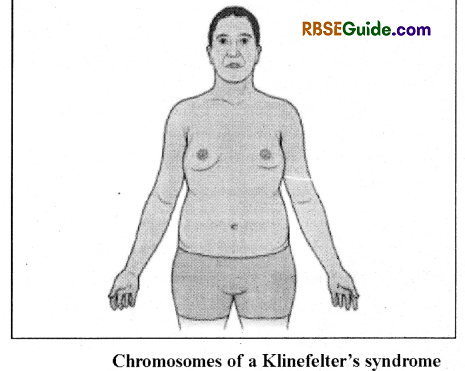
(i) In 2A + XXX condition (47), the female have usually normal genitalia, limited fertility and slight mental retardness.
(ii) Higher doses of X chromosomes may lead to more pronounced effects. In male, the mammary glands are like female and this, condition is called Gvnaeconiastia (gynae = woman and massere = male with mammae)
(iii) Hands and Legs are long as compare to normal one.
Super Female
In w omen sometimes total number of chromosomes may be upto 47 to 49. This increase number is due to additional X chromosomes-
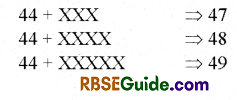
Symptoms
- Such women are of low mentally ability.
- Dealyed sexual development
- Highly beautiful
- More emotional
Jacob’s syndrome
- It is also called as criminal syndrome.
- It is caused due to one extra Y-chromosome in Man (44 + XYY = 47)
- Symptoms
- (i) Abnormal development of sex organs.
- (ii) Exceptionally tall and stout body.
- (iii) Low mental level
- (iv) Criminal tendency since birth.
![]()
Linkage
General
Mendel’s principle of independent assortment is truely applicable for both genes and chromosomes. Genes control various characteristics of the organisms and gene is a basic unit of heredity.
First time German scientist Sutton studied inter-relationship between factors and chromosomes. He discovered linkage.
According to him in each pair of chromosome one chromosome is from each parent, (paternal and maternal member). It is the reason by which the genes present on separate chromosomes are independly assorted, but all genes present on the same chromosome are said to be linked and should be inherited together.
Asingle chromosome may carry a large number of genes. All the genes located on the same chromosome are said to be linked genes. The characters controlled by these genes are said to be Linked characters.
These linked genes have a tendency to be inherited together but independently. Genes present on a single chromosomes are not independently assorted.
Bateson and Punnet (1906) explained about linked genes in his experiment on sweet pea (Lathyrus odoratus).
Experiment:
Bateson and Punnet (1906 ) did a dihybrid cross on plants of blue flowers and long pollens with red flower and round pollen plant and found following results :
[Abbreviations : Blue flower = B. Red flower = b, Long pollens = L and round pollens = l.]
(i) A cross between Blue flower and long pollens (BBLL), and red flower and round pollens yielded blue flowers and long pollens in F generation.
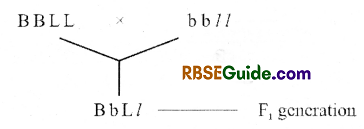
(ii) Now they made a test cross between heterozygous ly offsprings (B b L l) with homozygous recessive parent (bbll).
By the concept of linked genes and independent assortment BbL/ should give four kinds of gametes and hence four phenotypes in equal proportions 1 : 1 : 1 : 1 were expected. But Bateson and Punnet obtained following results-
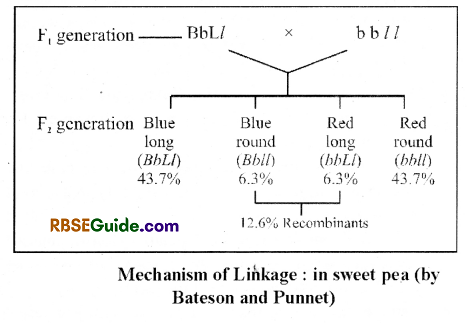
The above results in 7 : 1 : 1 : 7 ratio were obtained. This suggests that new combinations or recombinants were less and number of parental plants were more. It means the selected genes for study were not followed law of independent assortment, but their nature showed linked inheritance or they show Linkage. The genes present on same chromosome show their natue to inherit together are called Linked genes and the incidence is known as Linkage. Sometimes a group of genes found on a single chromosome are inherited together, is called Linkage group.
![]()
Types of Linkage:
Linkage is of two types :
Complete linkage:
When certain genes located so nearly on the same chromosome and tend to remain linked together while passing from one generation to another without new combinations is termed complete linkage.
Incomplete linkage:
Linked genes are not inherited always in their combination. In the homologous chromosomes or at the time of meiosis exchange of such genes may be found due to crossing over. The genes located at distance on the chromosome are also incompletely linked because more chances of isolation by crossing over in these.
Crossing Over
General
Bateson and Punnet obtained some recombinant type plants during experiments. It is because of a special process called crossing over.
In crossing over exchange of genetic material takes place between non-sister chromatids of homologous chromosomes. It results in the formation of new combinations.
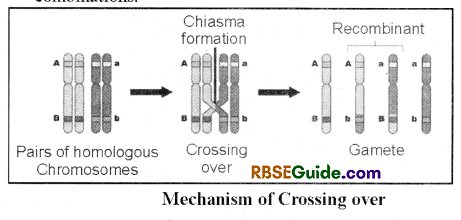
During phrophase I of meiosis there is an exchange of parts of chromatids between homologous chromosomes. The homologous chromosomes become interwined and the chromatids of homologous chromosomes cross over at certain point called Chiasmata. The Chromatids break at this point and then rejoin. Crossing over results in the exchange of corresponding segments at the same locus between the paternal and matefnal chromosomes (means nonsister chromatids of homologous chromosomes). Linked genes separate from each other by crossing over (Fig.) and new combinations appear.
Types of Crossing over
On the basis of number of Chiasma formation in the chromosomes, the three types of crossing over are found:
(a) Single Crossing over : When only one . chromatid of homologous chromosomes participate in crossing over and only one chiasma is formed. It is called Single crossing over.
(b) Double crossing over: When two, three or all four chromatids of homologous, chromosomes participate in crossing over and two chiasmata are formed. It is known as Double crossing over.
(c) Multiple Crossing over: When more than two chiasmata are formed between two nonsister chromatids. It is called multiple crossing over.
Significance of Crossing Over
- This process occurs during pachytene stage of prophase I of meiosis.
- It occurs between non-sister chromatids of homologous chromosomes.
- Exchange of segments or genes between non-sister chromatids is known as Crossing over.
- Numbers of points of a chromosome where crossing over takes place at single time depends on the length of the chromosome. Percentage of crossing over increases with the increase in the length of chromosome.
- Distance between the genes in a chromosome alfect probability of crossing over. More distance between genes incrase probability of crossing over and if distance is less than there is decrease in probability of crossing over.
![]()
Sex linked inheritance:
General
Human female has XX chromosomes and human male has XY chromosome along with 44 autosomes in both sexes.
The genes present on X chromosome may express in both male and female gender arid hence it is called cris-cross heredity. While genes present on Y-chromosome found only in male.
Genes of approximately 20 characters found on X chromosome of human are sex-linked characters and a father can not transmit sex linked traits (of X- chromosome) to his sons, it can be passed on to the daughters only.
Some of the sex linked hereditary diseases found in human beings are as follows :
Colour blindness:
General
It is a hereditary disease. In this disease, the person is unable to differentiate different colours.
The colourblindness is of two types-
- Red-Green colourblindness
- Blue colourblindness
This disease is mainly found in men because males have only one X chromosome. If X-chromosome contains recessive allele of pigment formation gene than no cone formation takes place and man suffer from colour blindness. While two X-chromosomes are found in woman and hence woman may be carrier of this disease or may suffer from this disease.
Red-Green colour blindness
It is caused due to absence of red/green cones and it is also called as protanopia/Deuteranopia.
The person is unable to distinguish red, green, yellow and orange colours. These colours appear to red in absence of green cones and green in absence of red cones.
Blue colour blindness
- It is caused due to absence of blue cones.
- Such person is unable to distinguish voilet, Indico, Blue and Green colours. They all appear to be green.
Inheritance of colourblindness.
Example 1 : Cross between normal woman and colourblind man.
If a colour blind male marries with a normal female the possibilities would be – All children (son and daughters) would be normal, but the daughters would be carriers. Because they are heterozygous, they will not be colourblind.
The woman acts as carrier of colourblindness.
Example 2 : Cross between carrier woman and colourblind man.
In this cross, 50% girls will be colourblind and 50% girls will be carrier. Similarity, 50% boys will be normal and 50% boys will be colourblind.
Conclusion : Following are conclusions regarding heredity of colour blindness :
(i) Identification of colours in the vision is a sex linked character. Its gene is located on the X chromosome and its allele is not found in males.
(ii) Males are more sufferer from this disease. Because if normal gene for colour differentiation is absent on X chromosome man than the colour blindness disease is found.
(iii) Women has two X-chromosomes and both X chromosomes have gene for colour identification and expression. While only one chromosome in man has gene for colour identification and expression. If only one X chromosome carries recessive gene for colourblindness in woman than the normal woman becoms the carrier of disease.
(iv) Gene for identification of colours is dominant. If both X chromosomes of woman carry this recessive gene then woman will be colour-blind.
(v) Father and son of a colourblind woman is also colour blind. If husband of a colour blind woman is also colour blind than their daughters will be colour blind. Daughter (normal) of a colour blind father produce 50% sons of normal vision and 50% sons as colourblind.
![]()
Haemophilia or Bleeder’s disease
It is a sex-linked hereditary disease which results in delayed or no blood clotting.
It was first discovered by John Otto. Haldane discovered haemophilia in the family of Queen Victoria. It is caused due to one recessive gene on the X – chromosome of man. It is also called as Royal disease or bleeder’s disease. It is expressed only in men
The women act as carrier of this disease. Recessive genes on both the X-chromosomes cause haemophilia in females but they do not survive. .
Father of haemophilia female is always haemophilic. Haemophilia is of 2 types:
- Haemophilia-B or Cristmas disease : It is caused due to absence of factor-IX. It is a weak type of haemophilia.
- Haemophilia-A : It is caused due to absence of factor-VIII (AHG).
This disease is also due to recessive gene located on X chromosome. Haemophilic man and normal woman produce 50% carrier daughters and 50% normal sons. Carrier woman and normal man produces 25% carrier daughters, 25% haemophilic sons, 25% normal daughters and 25% normal sons.
This disease is found only in males as males have only one X chromosome. If woman has both recessive genes on their X chromosomes than such w oman cannot survive, because blood flow during menstruation do not stop and hence it is fatal for them. When females contain only one recessive gene of haemophilia on X chromosome and other X chromosome with out such gene, they are c airier of haemophilia.
